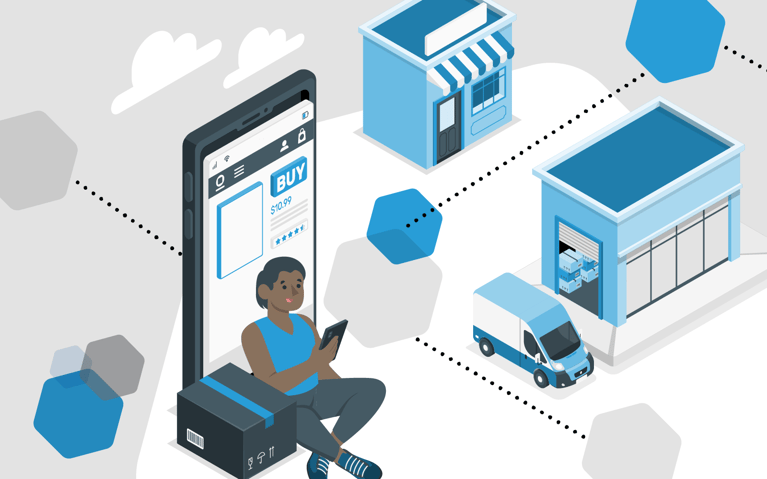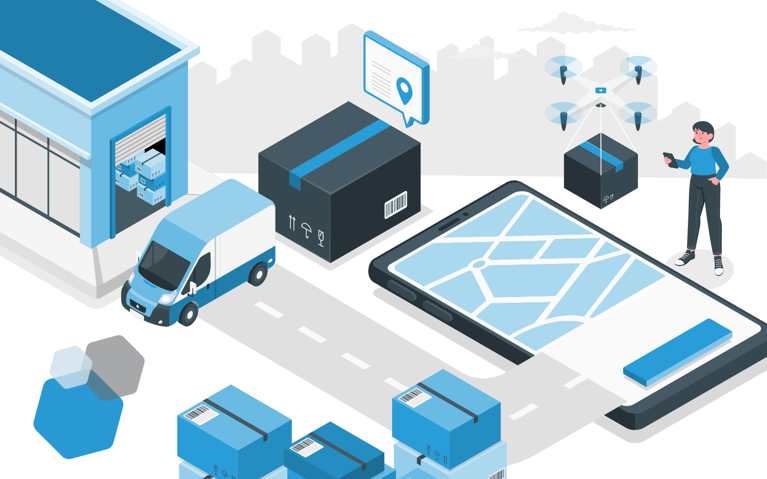Fulfillment is the backbone of your brand's operations, ensuring that products are delivered to customers efficiently, cost-effectively and accurately. Omnichannel fulfillment operations directly impact the customer experience, having an affect on satisfaction and loyalty. Timely and well-handled deliveries enhance the overall shopping experience and can lead to higher customer retention rates. Moreover, effective fulfillment processes contribute to brand reputation, differentiation and competitiveness in the retail ecommerce market.
Why is fulfillment important?
Imagine a near-perfect customer journey: The consumer discovers your product, engages with your content, social accounts and reviews, the checkout is a breeze (they’re delighted and excited!), and then…the post-purchase experience is a disaster. It’s a late delivery, damaged product or the wrong item altogether – no matter the issue, it factors highly into the customer experience. And since it’s their final memory, it’s the one that sticks.
The post-purchase experience greatly influences shoppers. A recent survey of consumers found that 79% admitted they wouldn’t purchase from a brand again after a bad post-purchase experience. The quality of your ecommerce fulfillment operations directly affects building a loyal customer base. In short, the period from purchase to delivery can make or break your brand.
What is ecommerce fulfillment?
Ecommerce fulfillment is the process of receiving, processing and delivering online orders to customers. It starts with storing inventory in warehouses or fulfillment centers, where products are picked, packed, and prepared for shipment. Once an order is placed online, it’s transmitted to the fulfillment center, where workers retrieve the items from shelves, package them securely and label them for shipping. After packaging, orders head to their final destination through shipping carriers and services. Ecommerce fulfillment orders are tracked and managed throughout this process to ensure timely and accurate deliveries. Additionally, many fulfillment providers handle returns processing, where items are received back from customers and restocked or processed for resale.
The stages of ecommerce fulfillment
Fulfillment starts when an order is received. Ideally, you have a robust Order Management System (OMS). It should give you end-to-end order tracking regardless of channel and the ability to change orders, shipping methods, etc., easily. From there, fulfillment includes the following steps:
Inventory storage and management
Brands store and manage inventory in designated locations within a warehouse or fulfillment center. Upon receipt, each item is assigned a unique identifier (SKU) and placed in a specific area based on factors like size, weight and demand. Inventory levels are continuously monitored and updated in real-time using inventory management software to track stock levels and ensure accuracy. When orders are received, inventory management systems coordinate the retrieval of products from storage locations for order fulfillment, optimizing efficiency and reducing errors.
Picking and packing
Picking is the retrieval of items for an order. The right type and number of products are “picked” from the warehouse to prepare for shipment. Packing includes placing the item(s) in the proper container for shipping, such as a box or bag, often with additional protective materials to prevent damage during transit. Labels are printed and added, readying the order for the carrier. While the pick-pack-ship process seems relatively simple, it requires consideration and the proper method to optimize efficiency and keep it cost-effective.
Shipping
Shipping gets your items into your customers’ hands. Carriers pick up packages for delivery and are tracked until they reach your customer. The software updates the status and adjusts inventory levels accordingly.
Returns management
Reverse logistics is a reality for today’s ecommerce brands. Since customers don’t always have the same ability to physically see or try products before purchase, retailers must factor in returns. Your fulfillment operations facilitate returns management: The process in which a customer sends an item back and it is received, inspected, refurbished, re-packaged, re-ticketed, disposed of or placed back into inventory.
Ecommerce fulfillment models explained
Ecommerce fulfillment models are various strategies for storing, picking, packing and shipping orders to customers. The most common models include in-house fulfillment, drop-shipping, third-party fulfillment (3PL) or a hybrid of these approaches.
In-house fulfillment
In-house fulfillment (also called dedicated or self-fulfillment) is when a company handles its own fulfillment operations internally. Brands handle storing inventory, picking, packing and shipping within their own facility.
Pros of in-house fulfillment
- Control: Businesses have complete control over the entire fulfillment process, allowing for greater customization and flexibility.
- Cost savings: With no third-party fees, in-house fulfillment, particularly for small or startup brands, can be more cost-effective for businesses.
- Brand representation: Direct interaction with orders allows for a more personalized customer experience, enhancing brand reputation and loyalty.
Cons of in-house fulfillment
- Infrastructure costs: Setting up and maintaining warehouse space, equipment and staff can be expensive and time-consuming.
- Scalability challenges: In-house fulfillment may struggle to accommodate fluctuations in order volumes, especially during peak seasons.
- Operational complexity: Managing logistics, inventory and shipping requires expertise and resources that businesses may lack, leading to operational inefficiencies.
Dropshipping
Dropshipping is when a business doesn’t store products, but instead they are held with the manufacturer until an order is placed and then shipped directly to the customer. In this retail fulfillment method, the brand doesn't keep the inventory it sells stored. The item may pass through the fulfillment or distribution center for processing, but is immediately shipped out.
Pros of dropshipping
- Low upfront costs: Dropshipping eliminates the need for inventory investment, reducing the initial financial burden for businesses.
- Minimized inventory risks: Since products are only purchased after they've been sold, businesses can avoid the risk of excess inventory or unsold stock.
- Scalability: Dropshipping allows for easy expansion into new products or markets without the constraints of physical inventory management. Businesses also have a quick turnaround time, allowing them to sell more items in a shorter window of time.
Cons of dropshipping
- Lower profit margins: With additional fees and wholesale pricing, dropshipping typically yields lower profit margins compared to traditional retail models.
- Less control over inventory and fulfillment: Businesses relying on dropshipping must depend on third-party suppliers for product availability and shipping, potentially leading to delays or quality issues. Additionally, brand reputation is affected if there are any issues since the customer is dealing directly the merchant site.
- Competitive marketplace: Dropshipping is a popular model, meaning businesses face increased competition and challenges in standing out among other retailers.
Third-party logistics (3PL)
Third-party logistics (3PL) outsources logistics and supply chain management functions to a specialized company. These companies provide services such as transportation, warehousing, fulfillment and distribution.
Pros of third-party logistics
- Expertise and resources: 3PL providers have specialized knowledge and infrastructure, allowing businesses to leverage their expertise without the need for in-house investment.
- Scalability: Outsourcing logistics functions to a 3PL enables businesses to scale operations up or down quickly to meet changing demand without the burden of fixed costs.
- Focus on core competencies: By delegating logistics tasks to a 3PL, businesses can focus on their core competencies and strategic initiatives, improving overall efficiency and competitiveness.
- Modern technology: The right 3PL partner offers state-of-the-art technology that gives you end-to-end real-time visibility into your fulfillment operations, inventory and orders. It provides integrations that supports omnichannel selling and fulfillment.
Cons of third-party logistics
- Loss of control: Businesses may have less control over the logistics process when outsourcing to a 3PL, potentially leading to issues with visibility, communication and quality assurance. However, the right 3PL service combats these issues, and still gives you the flexibility and customizability you need and the ability to oversee and help control your operations, effectively creating a strategic partnership.
- Dependency on third-party providers: Reliance on external providers for critical logistics functions can pose risks in terms of service reliability, flexibility and responsiveness to changing business needs. A strong 3PL service diversifies their partners, ensuring that they can be responsive and adaptable and meet their customers’ needs.
- Cost considerations: While outsourcing logistics can offer cost savings in some cases, businesses must carefully evaluate the financial implications, including service fees, contract terms and potential hidden costs. This is where choosing the right 3PL partner is critical.
What to consider when choosing an ecommerce fulfillment model
Several factors should be considered when choosing the right fulfillment model for your brand:
Location
Evaluate the geographic proximity of fulfillment centers or inventory storage to your target customers or customer base to minimize shipping costs and transit times. Look at whether you need a multi-node network and where your products need to be to guarantee one- or two-day shipping.
Order volume
Ecommerce retailers first starting out may not require warehouse space and an automated process. However, as businesses grow, you must ensure that your fulfillment model can accommodate fluctuations in order volume, facilitating efficient order processing during peak seasons, promotions or other events. Another consideration should be how much scalability you may need and look at which model best supports that.
Order processing, inventory management and product type
Assess the capabilities of the fulfillment model in handling order processing, inventory tracking and management to maintain accurate stock levels and prevent stockouts. Consider the nature of your products, including size, fragility and storage requirements, to ensure compatibility with the chosen fulfillment model. Think about the number of SKUs you may have or how many returns you will likely get. Beauty fulfillment, apparel fulfillment and footwear fulfillment differ greatly from electronics or healthcare fulfillment.
Cost considerations
Evaluate the overall cost structure, including fulfillment fees, storage fees, shipping rates and any additional charges associated with the fulfillment model, to determine its financial viability.
By carefully considering these factors, businesses can choose a fulfillment model that aligns with their specific needs and objectives, optimizing their logistics operations for success.
Cart.com for your ecommerce fulfillment needs
Fulfillment expectations have changed. Customers are looking for an exceptional post-purchase experience that only streamlined fulfillment operations tailored to your unique business needs can handle. Whether you're scaling your operations or seeking cost-effective solutions, Cart.com offers customizable fulfillment services for your logistics. Take the first step towards efficient order processing and seamless shipping by partnering with us. Contact the expert team at Cart.com today to delight your customers from discovery to delivery.
Subscribe to our emails for the latest industry insights!
By entering your email, you agree to receive marketing emails from Cart.com






